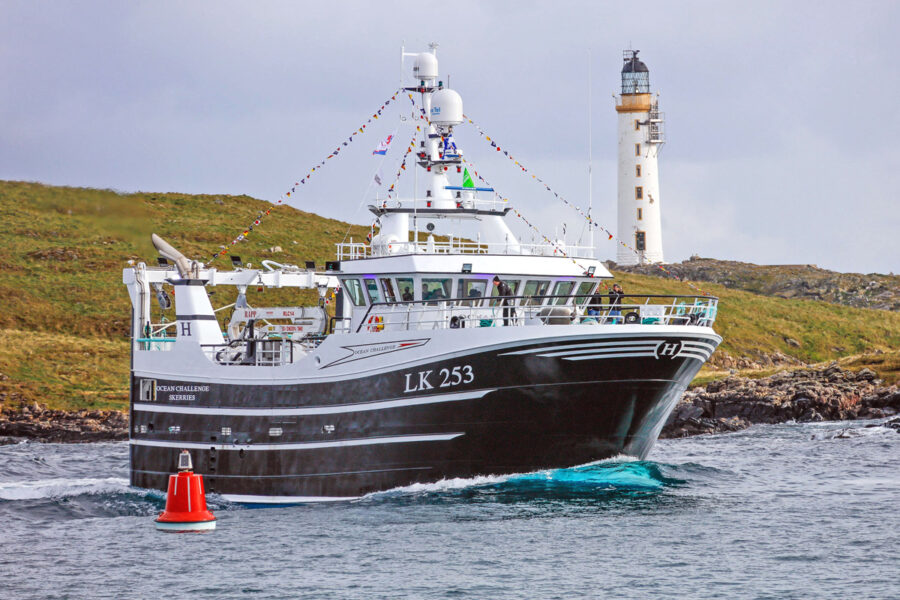The newest addition to the Shetland whitefish fleet, the 28.5m twin-rig stern trawler Ocean Challenge LK 253 fished a quick fire maiden trip at the end of October before landing 400 boxes at Lerwick, reports David Linkie. Photographs by Alan Hennigan, Julian Ramsey, Ivan Reid, Sydney Sinclair and David Linkie
Fishing less than 30 miles from harbour, Ocean Challenge’s shake-down trip was curtailed by severe south-easterly gale and winds of over 50 knots. Skerries father and son skippers Leslie and Steven Hughson were fully satisfied with the level of performance from Ocean Challenge on the first trip, when the boat, together with all onboard systems and fishing gear, performed well from the first tow.
Delivered by Mooney Boats Ltd of Killybegs, Ocean Challenge was built to replace two 23m and 24m twin-rig trawlers, Fairway II LK 270 and Ocean Way LK 207, which had a combined age of 55 years.
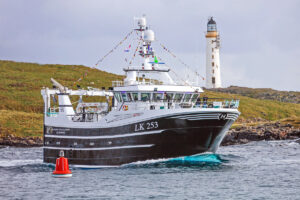
01. Ocean Challenge passing Out Skerries lighthouse when heading into Skerries pier for the naming ceremony.

02. General view of the fish-handling area, with the Kronberg Mk III gutting machine in the foreground.
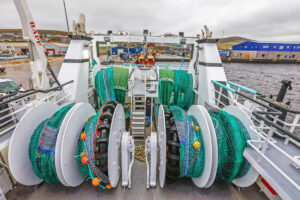
03. Looking aft over the net and bagging drums.
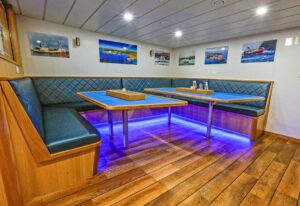
04. The spacious messdeck.
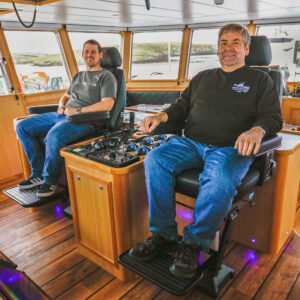
05. Skerries father and son skippers Leslie (right) and Steven relax in the wheelhouse seats before the hard work begins.
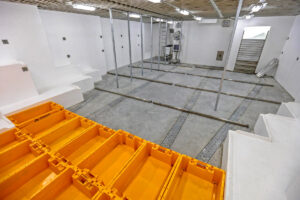
06. General view of the fishroom, which can accommodate 1,350 stacker boxes.
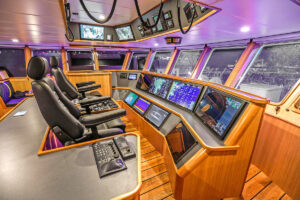
07. Looking to port across the forward wheelhouse console.
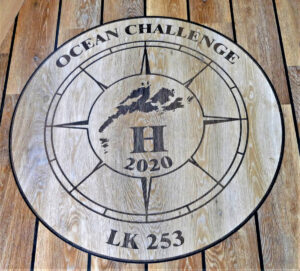
08. The map of Skerries is depicted in a wheelhouse floor crest.
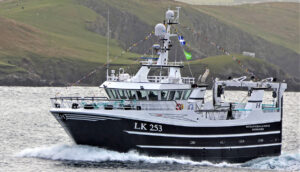
09. Ocean Challenge arriving at Lerwick for the first time.
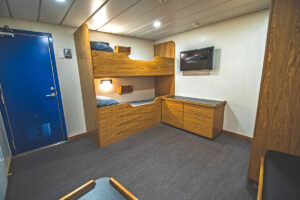
10. The two-berth skipper’s cabin is located at shelterdeck level.
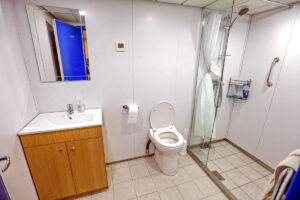
11. One of two spacious shower rooms on Ocean Challenge.
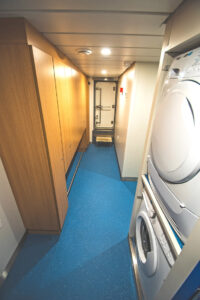
12. Laundry facilities are built into the crew’s deck wardrobe on the main deck.

13. The galley on the starboard side…
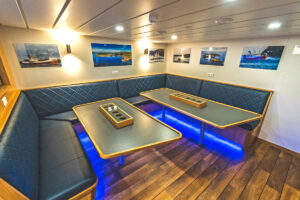
14. … is positioned forward of the adjacent messdeck…
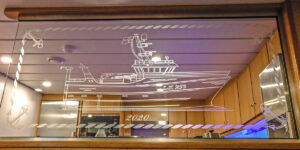
15. … and separated by a glass panel engraved with a profile of Ocean Challenge.
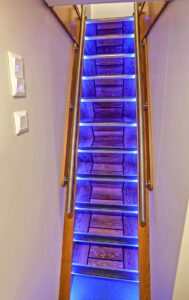
16. Low-level lighting is fitted throughout the accommodation areas for crew safety.

17. The walk-in electronics room is positioned directly below the wheelhouse.
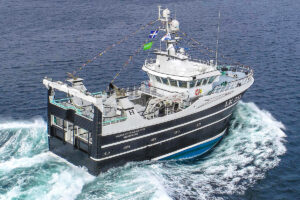
18. A starboard quarter aerial view of Ocean Challenge.
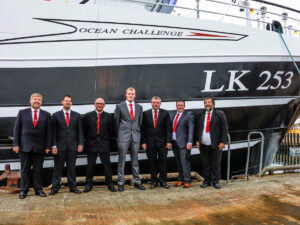
19. The skippers and crew at Ocean Challenge’s naming ceremony on Skerries. Left to right: Leslie Hughson, Steven Hughson, Arthur Johnson, Callum Nicol, David Wynn, Paul Moodie and Leonard Johnson.
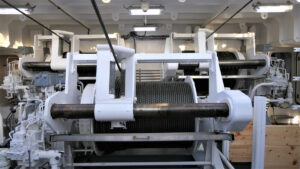
20. Three MacGregor split trawl winches are arranged in a triangular formation on the shelterdeck abaft the accommodation casing.
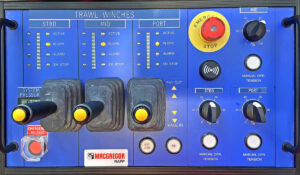
21. The winch control panel in the wheelhouse…

22. … and the display screen for the MacGregor autotrawl system.
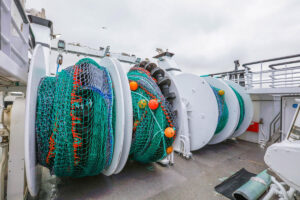
23. Two sets of split net drums are positioned midway along the trawl deck…
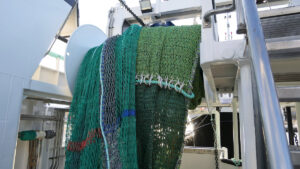
24. … forward of two bagging drums.
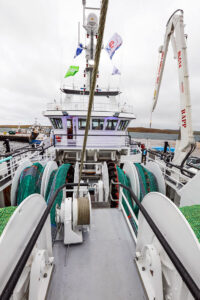
25. Looking forward along the trawl deck, with the codend Gilson in the foreground.
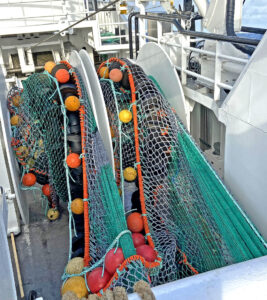
26. Hauling the starboard net onto the drums.
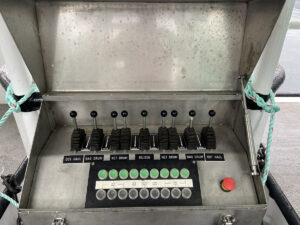
27. All the deck machinery can be operated from a set of controls on the trawl deck.
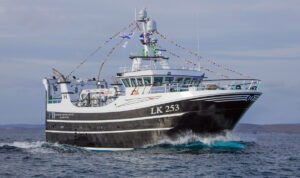
28. Ocean Challenge returned an average top speed of 10 knots on sea trials from Killybegs.
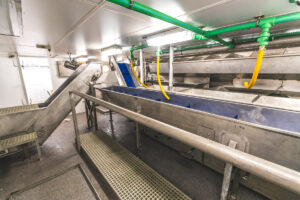
29. A short elevated conveyor leads fish forward from the reception hopper…
Ocean Challenge’s arrival shortly after new whitefish markets opened at Lerwick and Scalloway represents another welcome boost for Shetland’s whitefish sector, and in particular the small outlying community of Out Skerries, which has a population of 60 and is home to two other locally owned vessels, Renown JW LK 52 and Sharyn Louise LK 250.
The Hughson family have lived in and fished from Out Skerries for generations. This continuing tradition was highlighted by the fact that within 24 hours of arriving at Lerwick, at the end of a 440-mile delivery passage from Killybegs completed in 46 hours, skipper Leslie Hughson had berthed Ocean Challenge alongside the small pier at Skerries, before his wife Dianne named the vessel on what was a proud occasion for all concerned.
Ocean Challenge is the first new whitefish vessel to be built for Skerries owners since skipper John David Anderson and his sons took delivery of the Campbeltown 87 Alison Kay LK 57 in 1988. The previous two new vessels, Comet LK 253 in 1971 and Horizon LK 250 10 years later, were both built for the Hughson family.
Although the lead-in time – including initial discussions, design, tendering and build – for any new vessel is considerable, when skipper Leslie Hughson signed the contract to build Ocean Challenge with Lee Mooney at the Aberdeen fishing exhibition in May 2018, no one could foresee the delays that would be experienced due to the outbreak of the global Covid-19 pandemic, shortly after the bare hull and superstructure had been towed to Killybegs from Poland for machinery installation and fit-out by Mooney Boats Ltd.
With the owners unable to travel from Shetland to Co Donegal for hands-on discussions regarding the all-important fine detail of the onboard arrangements, Mooney Boats quickly found ways to overcome this problem. The yard’s design team produced sophisticated 3D drawings of various layouts, which were sent digitally to the vessel owners to review, enabling them to ‘walk around’ proposed designs on their tablets and laptops.
The 3D design drawings of the accommodation areas, wheelhouse and engineroom proved extremely successful, and led to the owners using the same process for the design of the automated catch-handling system.
The eighth in a succession of whitefish vessels designed by Ove Kristensen of Vestværftet ApS for owners in Scotland, Orkney and Shetland, Ocean Challenge is the biggest new boat to be completed to date by Mooney Boats Ltd.
Working through LHD Ltd, Ocean Challenge skippers Leslie and Steven Hughson, together with crewmen Arthur Johnson, Leonard Johnson, Paul Moodie, Callum Nicol and David Wynn, are expected to settle into a regular pattern of making three landings spread over 14 days. Fishing activities will be focused on Shetland grounds for most of the year, apart from some seasonal activity at Rockall.
While Ocean Challenge was rigging out at Lerwick in preparation for fishing trials, skipper Leslie Hughson said: “In all respects, Ocean Challenge is a superb tribute to the Mooney Boats team. The level of internal finish speaks for itself, and far exceeds any expectations we might have had. The same applies to the machinery, hydraulic and electric installations.
“Given the challenges created by Covid-19, the yard, together with the other main sub-contractors, should take great credit for what they have achieved.
“All good things come to those who wait, and now we are keen to get going and start to prove Ocean Challenge’s fishing capabilities.
“Clearly this boat represents a strong statement of confidence in the future of fishing in Shetland, and as such is an investment in the next generation of local fishermen.
“Stock levels on grounds around Shetland have been highly encouraging for some time now. With Brexit just around the corner, there is no doubt that we have taken delivery of Ocean Challenge at a pivotal and hugely critical time, not only for the fishing industry here in Shetland, but also in the UK.
“The recent build-up of effort by foreign vessels fishing continuously around Shetland – which after all are our own waters – is well documented. Clearly there are far too many boats working static gear. Apart from taking our fish and impacting on stock levels in years to come, French and Spanish vessels working longlines and gill-nets are closing vast swathes of our traditional fishing grounds. That simply cannot be right.
“Although it will inevitably take time for changes to be implemented once the UK becomes an independent coastal state, the direction of travel is clear, in that the presence of EU-registered vessels fishing in Shetland waters would be reduced.
“Given that fishing makes by far the highest contribution to the Shetland economy annually, this will be a good thing for our industry and future generations of fishing-dependent families – as long as it starts to happen as quickly as possible.”
Vessel layout
Built to Class at the Nauta shipyard in Gdynia, Ocean Challenge’s new design of round bilge steel hull has main dimensions of LOA 28.5m, registered length 23.99m and beam 8.7m. Following the launch in October of last year, Ocean Challenge was towed from Poland to Killybegs for completion by Mooney Boats Ltd.
The design and build process was monitored throughout to +1AI by Bureau Veritas as the certifying authority, which also carried out the plan approval.
Ocean Challenge features three full-length decks: main – accommodation/catch-handling systems; shelter – gear-handling activity, skippers’ cabins; superstructure deck – protection for trawl deck.
Layout below the main deck consists of forepeak freshwater tank, bow thruster compartment flanked by deep fuel tanks, fishroom, engineroom, and aft peak housing Scan AS steering gear, fuel, daily service, hydraulic and lube oil tanks.
Arranged across the forward section of the main deck, the main accommodation areas replicate the modern appearance and superbly finished internal spaces that feature throughout Ocean Challenge. LED strip lighting is a valuable safety feature on the two accommodation decks, which are also fitted with underfloor heating.
Abaft the forepeak, which provides generous storage for dry and frozen provisions, a well-equipped galley is arranged to starboard, forward of a spacious messdeck/TV lounge with bench seating surrounding two tables.
From the messdeck, a door leads to a central lobby area that gives access to the rest of the accommodation areas. These include a two-berth cabin forward of the galley, two single-berth and two twin-berth cabins on the starboard side, forward of a large shower and WC room, and a rectangular deck wardrobe with the customary full-height storage lockers, which exits onto the fish-handling deck. A walk-in compartment housing two Buus flake ice machines, together with the compressors for the fishroom chilling system, is also built into the port side of the deck house.
Single and twin-berth skippers’ cabins are positioned port and starboard at shelterdeck level in the accommodation house, along with a central shower/WC room, an electronics room and two workshops/stores accessed externally from the trawl deck.
An extensive automated catch-handling system, designed, fabricated and fitted by Mooney Boats, is arranged across the full beam of Ocean Challenge, between the forward accommodation casing and the large central catch-reception hopper aft. Capable of holding around 250 boxes of whitefish, the chilled hopper is flanked by two storerooms, with the one on the port side also housing an air-cooled Caterpillar 4.4DIT harbour genset.
Engineroom
Ocean Challenge’s spacious aft engineroom, which is characteristic of this design of vessel, features a particularly well-thought-out arrangement.
Developing 738kW @ 760rpm, the ABC 6DZ straight-six main engine is coupled to a Heimdal HG660S 6.04:1 reduction gearbox to turn a Heimdal 3,000mm-diameter four-bladed CP nickel-aluminium-bronze propeller mounted in a matching high-efficiency nozzle. The centreline propulsion system is operated through one of three sets of Lyngaa electronic engine controls strategically positioned in the wheelhouse.
Ocean Challenge recorded an average top speed of 10 knots on sea trials from Killybegs.
Two Caterpillar 9.3 DITA auxiliary engines drive 250kVA Leroy Somer 415/3/50 generators. The electrical generators are fully synchronised through the switchboard panels to give load-sharing and automated auxiliary start-up.
The engine exhausts are routed up through a stylishly raked coaming to starboard forward of the trawl gantry.
A Caterpillar 4.4 DIT air-cooled harbour genset is located in a workshop on the main deck aft.
A hydraulically operated Hundested bow thruster of 190kW is fitted, to give maximum vessel manoeuvrability in restricted areas.
Ocean Challenge can start a trip carrying 50,000 litres of fuel, housed in a combination of four main deep tanks (two forward and two aft), a daily service tank in the aft peak, two wing tanks in the engineroom and a double-bottom tank under the fishroom. An electronic tank gauge (duplicated in the wheelhouse) is conveniently placed in the engineroom adjacent to the pipe manifolds leading from the various tanks, allowing the engineer to see exactly how much fuel he is transferring.
Freshwater capacity is 27,700 litres. This total includes 14,400 litres in a bulbous bow tank primarily for domestic use, and 12,700 litres in two double-bottom tanks under the fishroom floor serving the Buus ice machines. The 8,740 litres housed in an anti-roll tank, located across the vessel’s full beam forward of the accommodation area at shelterdeck level under the wheelhouse floor, can also be used to supplement freshwater supplies should the need arise.
Trawling arrangements
The full package of deck machinery fitted on Ocean Challenge was manufactured by MacGregor (GBR) Ltd, Peterhead, which also designed the hydraulic system.
The two-speed split trawl winches spooled with the outer wires are mounted on raised saddles either side of the vessel’s centreline on the shelterdeck, adjacent to the deck casing. The left- and right-hand winches have a core pull rating of 18.2t, and a capacity for 1,000 fathoms of 24mm-diameter wire in 15 layers.
A third winch, of similar specification, from which the middle wire is worked is mounted between, and slightly abaft, the higher-standing door winches.
From the winches, which are operated through a MacGregor PTS-Pentagon Cbus HF autotrawl system, the wires lead directly aft above the net and bagging drums to hanging blocks under the box-section transom trawl gantry.
In order to allow Ocean Challenge to tow from the optimum point in relation to sea and tidal conditions, the outer blocks can be moved across the gantry by using remotely controlled hydraulic rams.
Two sets of 2 x 16t split net drums are positioned at the head of trawl tracks on the shelterdeck, leading to shooting and hauling openings across the transom. These can be sealed off in poor weather by hydraulically operated stern doors capped with large-diameter rollers. With the stern already watertight up to shelterdeck level, this feature provides an added metre of protection that will prove invaluable when the crew are mending torn gear on deck in heavy weather.
Six hydraulically operated shooting poles are also fitted across the two gear-hauling openings.
Two 8t bagging winches are mounted at boat deck level towards the transom. This arrangement enables the wings and mouth of the single-rig trawls to be hauled by the net drums until the middle hoppers are just forward of the bagging drums, which are then used to take up the long taper and codend extension.
The codend is lifted centrally at the transom by a 9.6t Gilson mounted on the wrap-round boat deck that spans the transom, before being hauled inboard through the stern gantry and released through the hydraulically operated hatch of a 250-box-capacity reception hopper.
Outhaul duties are served by a two 5.4t winches mounted on the trawl gantry.
All the deck machinery can be remotely operated from the trawl console in the wheelhouse, from which skippers Leslie and Steven Hughson have a commanding view of all shooting, hauling and bagging activities. A full set of local controls are also positioned at the fore side of the codend hatch.
Ocean Challenge’s main hydraulic system is operated by three 172kW pumps driven from separately clutched PTO units fitted on the Heimdal gearbox.
When towing, hydraulic power to the split trawl winches is provided by two electrically driven 37.5kW pumps that also provide net-retrieve and in-harbour facilities.
Operation of the electric/hydraulic pumps is another of the functions performed by the MacGregor PTS-Pentagon Cbus HF autotrawl system, the control panel for which is mounted in the fishing console in the wheelhouse.
Strong emphasis on catch quality
The highly automated catch-handling system, together with the capability to produce 9t of flake ice per day and a chilled reception hopper, highlights the importance the owners have given to landing premium-quality whitefish caches.
Promoting maximum catch quality and full product traceability, from codend to consumer, starts as soon as fish are released through a hydraulically operated central hatch into the large reception hopper. Fully lined and insulated on the sides and base, the central hopper is also served by a chilling system comprising stainless steel pipes mounted on the underside of the shelterdeck. Effectively replicating the fishroom chilling system, this ensures that the temperature of the catch in the hopper is immediately lowered and controlled.
Ocean Challenge is equipped with a highly automated whitefish handling and catch-management system designed and fabricated by Mooney Boats, to deliver optimum levels of catch quality, while minimising the amount of manual effort required from the crew.
Having experienced the benefits of the highly efficient and user-friendly sophisticated 3D design drawings developed at the start of the Covid-19 pandemic to enable the design of the accommodation areas, the owners then asked the yard to design and fabricate the fish-handling system – a first for Mooney Boats.
A short elevated conveyor picks fish up almost from deck level at the forward port corner of the hopper and moves them onto a long waist-height conveyor arranged across the middle two-thirds of Ocean Challenge’s beam, from which the crew select and gut the catch while standing on a raised grating with their backs against a stainless steel rail.
After being gutted, selected fish are placed into either one of nine elevated bins, or four hoppers directly beneath.
A further three size selections of whitefish are made into troughs adjacent to the sorting conveyor, for delivery via an elevated conveyor to a Kronberg Mk III gutting machine positioned forward on the port side.
Fish from the central selection bins are released downwards into one of four integrated washers. The gutting machine is served by a dedicated washer, while a sixth is reserved for rough fish. After washing, all retained selections of fish are transferred to a drying bin, before being delivered via a chute to the fishroom.
On delivery to the starboard side of the fishroom, catches are electronically weighed, with part-basket weights stored on the vessel’s VCU catch-management system, before a label displaying all relevant information, including species, grade, size, time and date, is printed off and affixed to the end of the corresponding box. This information is also transferred automatically to a PC in the wheelhouse, where it is accumulated to provide a running total of Ocean Challenge’s trips.
Served by a dedicated easy-access companionway located to port, the fishroom on Ocean Challenge, which extends over more than half the boat’s registered length, can accommodate some 1,350 stacker boxes of whitefish. Supplied by LHD Ltd and manufactured by Craemer UK, the boxes are stacked 11 high.
The fishroom was extensively insulated and GRP-lined by Mooney Boats to ensure optimum levels of catch quality and hygiene.
The fishroom chilling system, which uses 22mm-diameter stainless steel refrigeration pipes mounted on the deckhead, was installed by KER Group. The Killybegs specialist also supplied two 2.5t Buus flake ice machines, which feed directly down to a 15t ice locker in the fishroom.
When landing, a 0.5t Pullmaster winch mounted on the underside of the shelterdeck aft of the landing hatch is used to pull stacks of boxes aft, before they are lifted ashore using a MacGregor 14t/m short-post stiff-boom landing crane served by a 2t winch mounted to starboard on the boat deck.
Scalloway and Killybegs companies supply and install wheelhouse equipment
Ocean Challenge is equipped with a comprehensive array of electronics equipment that was supplied by H Williamson and Sons Ltd of Scalloway for installation at Killybegs by Barry Electronics Ltd.
Entering Ocean Challenge’s wheelhouse for the first time, the immediate feeling is of space and orderliness, enhanced by the same superb level of natural wood finish that is evident throughout the boat.
The owners placed the emphasis fairly and squarely on a streamlined wheelhouse appearance, enhanced by ever-advancing electronics technology.
Two skipper’s chairs, supplied by E Vejvad Hansen, are positioned either side of an island console on the vessel’s centreline, which is extended aft to give a large chart table area and drawer storage behind the helmsmen’s seats.
Four Neovo QX 32in monitors are housed in the main island-style forward console, which is set back from the wheelhouse windows.
A further 17 Neovo RX24 monitors are located in an overhead console above the skipper’s seats, in which most of the communications equipment is mounted, above the slim wing steering consoles and around the trawl console aft.
A desk area housing the E-Catch reporting computers is positioned on the port side forward of hot drink-making facilities and a built-in sink.
Vertical bottom-sounding duties are handled by a Furuno FCV 1900G BB CHIRP and fish-sizing sounder, and a Furuno FCV 295 low-frequency (28kHz) unit.
Two Furuno GP-39 GPS receivers process details of the trawler’s position. Vessel heading is provided by a Furuno SC-70 satellite compass.
Ocean Challenge’s location is displayed at all times on two Sodena Easywin plotting systems interfaced to give a combination of AIS/ARPA, wind, tidal and chart overlays.
The main Furuno FAR 2228 BB 25kW radar is served by a 6.5ft antenna. The secondary radar set is a Furuno M1835 4kW unit with a 10in display screen and 24in radome.
Steering is handled by a Navitron NT921G autopilot complete with three joystick control sets.
The mandatory GMDSS communications required for the areas where Ocean Challenge will fish include a Sailor 6310 MF/HF 150W radiotelephone, Sailor 6222 Class A DSC VHF, Furuno NX-700B Navtex, Jotron Tron 60S GPS EPIRB, Tron Sart 20 and Entel HT649 handheld VHF.
Additional communications equipment includes two Sailor 6248 VHFs, Phontech 3101 10-way talkback system, Furuno VSAT system and Sailor SC4000 Iridium satellite phone.
An Entel HT644 handheld VHF enables the skippers to communicate with the crew on the trawl deck via Entel headsets built into their safety helmets.
A Seatel 80 satellite TV system delivers freesat coverage to seven 32in monitors fitted in the accommodation cabins.
Barry Electronics and Williamsons also installed a comprehensive IP-based CCTV system deploying 16 POE cameras, images from which are displayed at five independently controlled viewing stations.
As Shetland dealer for Scanmar, Williamsons also supplied the Scanmar 365 net-monitoring system that skippers Leslie and Steven Hughson are using to optimise twin-rig trawling efficiency on Ocean Challenge.
The system uses data from SS4 distance and angle door sensors directly integrated into the vessel’s autotrawl system to monitor the gear spread at all times.
Headline and symmetry sensors give data on the headline height speed of water flow through the nets. This information is interfaced to the MacGregor autotrawl system, enabling wire lengths to be constantly adjusted to keep the gear square.
Maintaining family traditions
By taking ownership of Ocean Challenge, father and son skippers Leslie and Steven Hughson are maintaining the Skerries family’s long association with fishing.
In 1971, Leslie Hughson’s late father skipper Jackie Hughson took delivery of the 77ft open-decked and wooden-hulled whitefish trawler Comet LK 253. Built by Sigbjorn Iversen Mek Verksted at Flekkefjord, Norway, Comet replaced Jackie Hughson’s previous 60ft boat, St Clair LK 250, which he had fished since 1957.
After first going to the fishing on Comet, Leslie Hughson and his brothers Colin and Norman took delivery of the Norwegian-built 55ft wooden-hulled whitefish trawler Horizon LK 250 in 1981.
Horizon was replaced 12 years later when the brothers bought the 67ft steel-hulled Swedish trawler Carmita LK 270, when her predecessor stayed in Skerries, being bought by Ewan and Willie Anderson.
Carmita was replaced in 2000 by the 23.24m Fairway II FR 603, bought from Fraserburgh skipper Jimmy Thomson. This trawler was built as Fairway II PD 603 in 1989 by Simek AS at Flekkefjord for Peterhead skipper Alex Summers.
In 2007, the Ocean Way Fishing Company bought Copious BF 237 from Buckie, when the twin-rig whitefish trawler was renamed Ocean Way LK 207. Buckie Shipyard Ltd delivered the 24.3m steel-hulled Copious in 1996 for Ian and William MacKay of Sandsend.
Ocean Way was lost 20 miles east of Shetland in March 2017, when the five-man crew were safely recovered from the sea by Lerwick lifeboat.
As Ocean Challenge was being fitted out at Killybegs, Fairway II was sold to the Whalsay partnership of Edward Leask and Ben, David, Grant and Ian Irvine, and renamed Endurance LK 416, in February of this year.
LHD twin-rig fishing gear
The LHD net and wire stores supplied a full package of twin-rig hopper trawls, wires and chandlery to Ocean Challenge, thereby continuing the owners’ longstanding relationship with the Lerwick companies.
Ocean Challenge is initially using twin-rig groundfish nets rigged on 150ft of 16in-diameter hoppers. With 160mm mesh in the top and lower sections, this trawl features a Dyneema headline and 8in deepwater floats.
Built to give low maintenance, Ocean Challenge’s nets incorporate three Magnet 7.2mm-diameter twine tearing strips and lace guards to ensure quick mending at sea.
LHD also supplied a full trawl chandlery package to Ocean Challenge, including Dyneema Gilson ropes, 5mm double Sicor high-tenacity codends and tunnels, and sweeplines, together with three 1,600m lengths of 24mm-diameter trawl wire.
Ocean Challenge is using a set of Thyborøn Type 12 1,100kg trawl doors and a 2,500t Thyborøn roller clump to spread the gear. Fifty-fathom sweeps are usually worked behind the trawl doors – longer when fishing in deeper water. From the doors, the standard sweeps are made up of 25 fathoms of 24mm-diameter wire and 25 fathoms of splits comprising 20mm mid-link ground chains and 18mm-diameter upper wires.
Resin deck coatings by PBP Services
The trawl and fish-handling decks on Ocean Challenge are coated with hardwearing non-slip resins from Lloyds-approved specialist Degafloor.
PBP Services of Fraserburgh sent a trained and experienced team to Killybegs to apply the four-coat resins as Ocean Challenge was nearing completion ahead of sea trials.
The only approved UK contractor for these specialist German resin products, PBP Services and its distribution partner Degafloor introduced them to the fishing industry seven years ago, since when they have become extremely popular with skippers, yielding excellent results.
The unique properties of the resins allow for the four-layer system to be applied and cured on the same day if required, with each coating curing in under one and a half hours, allowing almost immediate foot traffic after application.
The resin coating has elasticity properties to allow for movement of steel. This also makes it comfortable underfoot for long periods of standing time.
It is also very aesthetically pleasing, with its blended colours of anti-slip quartz suspended throughout the film thickness of the coatings. The resin is extremely hardwearing, tough and impact-resistant, and is easy to clean and maintain.
As well as Lloyd’s German shipping class certification, the product also comes with health and safety anti-slip testing and certification, and food and drink industry certification for safe production of factory foods.
Ella next for Mooney Boats
Machinery installation and fit-out is progressing well on the first of three midwater pair-trawlers designed by Ove Kristensen of Vestværftet ApS that Mooney Boats will complete for owners in Ireland.
Yard no. 49, the 27.46m Ella G 233, arrived in Killybegs in July, from Riga in Latvia. On completion, the vessel will replace the Atlantic Dawn Group’s 26m Star of Hope G 233.
Currently in build at the Stal-Rem shipyard, Gdansk, the 31m sisterships Eilean Croine S 238 and Sparkling Star D 437 are scheduled to arrive at Killybegs in the spring of next year.
Both boats will feature ABC main engines, Heimdal gearboxes, 3,400mm-diameter propellers and two Scania auxiliary engines.
The pair-team’s deck machinery will be manufactured by SeaQuest Systems of Killybegs.

